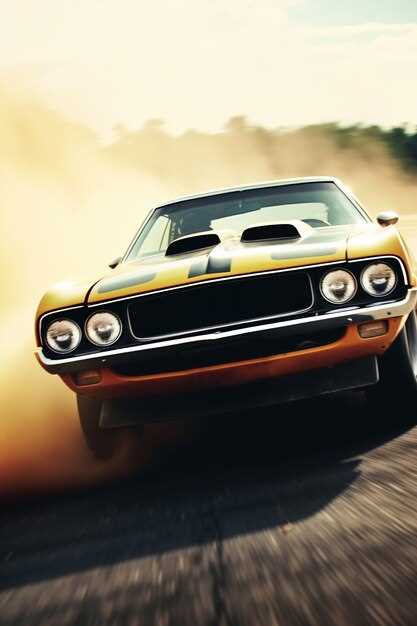For anyone passionate about cars, few experiences rival the thrill of driving a muscle car. These powerful machines defined an era, pushing the boundaries of speed and performance. The Ford Mustang, introduced in 1964, redefined American automotive culture with its blend of style and sheer power, igniting the pony car craze.
The Chevrolet Camaro quickly followed, offering fierce competition with its bold design and robust engine options. Its launch in 1966 enabled speed enthusiasts to choose between a range of configurations, including the legendary Z/28, which brought racing technology to the streets.
In 1970, the Plymouth Hemi ‘Cuda took muscular performance to another level with its high-performance Hemi V8 engine. The model became a symbol of raw power, showcasing the engineering advancements of the time. Each of these vehicles carved a niche in automotive history, setting the stage for the relentless pursuit of speed and performance in future models.
Impact of the Ford Mustang on American Muscle Culture
The Ford Mustang emerged in 1964, setting a new standard for American performance cars. Its introduction sparked a wave of excitement among car enthusiasts, defining the muscle car segment. The Mustang offered powerful engines, appealing designs, and price points that made it accessible to younger drivers.
Its influence is significant, as the Mustang created a blueprint for future models. Competitors like the Chevrolet Camaro and Dodge Challenger followed suit, adding to the muscle car phenomenon. The Mustang not only dominated the streets but also rooted itself deeply in American pop culture through movies, music, and events, symbolizing freedom and rebellion.
Performance-wise, the Mustang provided various engine options, from the standard inline-six to high-powered V8s. This versatility allowed buyers to choose according to their driving preferences, further broadening its appeal. Over the decades, the Mustang has continuously evolved, introducing innovations like fuel injection and turbocharging, ensuring its relevance in an ever-competitive market.
Here’s a quick overview of the milestones that showcase the Mustang’s impact:
| Year | Milestone |
|---|---|
| 1964 | Introduction of the Ford Mustang |
| 1966 | Reaches over 1 million units sold |
| 1970 | Launch of the Boss 302 and Boss 429 models |
| 2005 | Revival of the classic design with the fifth generation |
| 2015 | Introduction of the EcoBoost engine for better fuel economy |
The Mustang’s presence in motorsports also reinforces its status. Competing in various racing events, it has garnered a passionate fan base, showcasing its performance capabilities. This connection to speed and competition further cements its legacy within the muscle culture.
In conclusion, the Ford Mustang shaped not only a category of cars but also a cultural identity that resonates with millions. Its blend of performance, style, and accessibility continues to inspire new generations of car enthusiasts around the world.
How the Dodge Charger Redefined Power and Design
The Dodge Charger stands as a symbol of muscle car performance and innovative design. From its introduction in the late 1960s, it showcased formidable power with its available V8 engines, delivering exhilarating speed and acceleration that captivated enthusiasts.
Its bold and aggressive styling redefined what a four-door vehicle could look like, merging functionality with aesthetic appeal. The iconic split grille and sculpted body lines convey a sense of motion, even when stationary. The Charger’s design not only turned heads but also improved aerodynamics, enhancing performance on the road.
Under the hood, the Charger has continually evolved, offering powertrains that balance raw horsepower with modern efficiency. The introduction of supercharged versions, like the Hellcat, pushed boundaries, bringing muscle car performance to a new level. Drivers can experience torque and horsepower figures that rival dedicated race cars, ensuring heart-pounding moments behind the wheel.
Advanced technology plays a crucial role in the Charger’s evolution. Features such as adaptive suspension systems and performance-tuned steering provide an engaging driving experience. These enhancements allow for better handling and stability, making the Charger suitable for both daily driving and spirited outings.
Inside, the Charger embraces driver-centric design elements with high-quality materials and cutting-edge infotainment systems. Spaciousness offers comfort for passengers, while sporty touches maintain the vehicle’s heritage. The integration of modern safety features ensures a secure driving environment, aligning traditional muscle car appeal with contemporary needs.
The Dodge Charger remains a powerful statement in the automotive industry, blending muscle with sophistication. Its impact on performance and design is evident, as it continues to inspire both new models and the passion of car enthusiasts around the globe.
Chevrolet Camaro: The Muscle Car That Inspired Generations
The Chevrolet Camaro stands as a symbol of American muscle, captivating enthusiasts since its debut in 1966. Its sleek design and powerful performance make it an icon. From the very first generation, it competed fiercely against rivals like the Ford Mustang, offering drivers a blend of speed, style, and affordability. The Camaro’s ability to deliver exhilarating acceleration drew in muscle car fans and instigated a passionate following.
Throughout its history, the Camaro has evolved while retaining its core identity. The second generation, launched in 1970, introduced a more aggressive look and higher horsepower options, solidifying its place in automotive culture. In the late 1980s, the third generation came equipped with advanced technology, pushing boundaries in performance and efficiency.
The fifth generation, which debuted in 2010, marked a significant revival of the Camaro’s legacy. With retro styling reminiscent of earlier models and powerful V8 engine options, it captivated a new generation and reignited interest in muscle cars. Performance packages like the SS and ZL1 showcased astonishing horsepower, thrilling driving experiences, and superior handling.
Today, the Camaro continues to inspire with its aggressive styling and cutting-edge technology. Model variants, including the LT1 and ZL1, deliver exhilarating engine performance, high-end suspension systems, and modern infotainment features. Consider test-driving a Camaro to experience first-hand the rush it provides. Whether for daily driving or weekend racing, the Camaro remains a solid choice for anyone seeking raw power and excitement on the road.
Plymouth Barracuda and Its Role in Drag Racing History
The Plymouth Barracuda made waves in the drag racing scene from its debut in 1964. Its lightweight design and powerful engine options attracted racers eager to dominate the quarter-mile. The earliest models featured a 273 cubic inch V8, but enthusiasts quickly sought larger engines for heightened performance.
The addition of the 383 cubic inch and later the 426 Hemi engines solidified the Barracuda’s reputation as a formidable contender. In 1968, the Barracuda body was redesigned, improving aerodynamics and creating a sleeker silhouette. This change made it an even more popular choice for drag racers who wanted to maximize their speed on the track.
Plymouth invested in performance packages, making the Barracuda customizable for drag enthusiasts. Options like the Super Stock model became particularly coveted, enabling modifications that enhanced acceleration and reduced weight. The Barracuda’s success in local drag strips contributed to its legendary status, paving the way for future muscle cars.
In the early 1970s, the Barracuda continued to evolve, but with increasing regulations on emissions and safety, performance began to wane. Still, the drag racing spirit remained alive among loyal fans and racers. Custom builds and vintage racing events keep the Barracuda’s legacy actively celebrated today.
For those looking to dive into drag racing history, the Plymouth Barracuda stands out as a symbol of muscle car culture and performance innovation. Whether restoring a classic model or discovering its racing past, the Barracuda delivers a rich narrative that honors speed and competition.
Influence of the Pontiac GTO on Performance Standards
The Pontiac GTO set new benchmarks for performance in the automotive industry. It combined powerful engines with a refined design, establishing a formula that many manufacturers would follow.
The GTO’s introduction in 1964 marked a significant shift towards incorporating muscle into everyday driving. Key features contributed to this transformation:
- Powertrain: The standard 389 cubic inch V8 engine delivered an impressive 325 horsepower, pushing the limits of what consumers expected from a vehicle.
- Lightweight Construction: The GTO achieved a balance between power and weight, allowing for superior acceleration and handling dynamics.
- Styling: Its bold, aggressive look appealed to a younger demographic, changing consumer perceptions of performance cars.
Competitors took notice, leading to a surge in production of similarly styled vehicles. The GTO effectively launched the muscle car era, influencing various American car manufacturers:
- Chevrolet: The Camaro and later the Chevelle took inspirations from the GTO’s design and performance metrics.
- Dodge: The Charger and Challenger emerged in response, aiming for similar power and style.
- Ford: The Mustang blended aspects of the GTO’s performance appeal while establishing its own identity.
This ripple effect altered the expectations of consumers searching for excitement and performance in their vehicles. The GTO also played a significant role in automotive marketing and culture:
- Media Representation: The GTO became an icon in films and music, elevating its status to that of a cultural phenomenon.
- Performance Metrics: Other manufacturers began promoting horsepower and acceleration times as critical selling points, setting a new standard for future models.
- Customization: The market responded with aftermarket performance parts, further encouraging enthusiasts to modify and enhance their cars.
The legacy of the Pontiac GTO continues to resonate. It reshaped consumer expectations, effectively transforming the performance landscape in the auto industry. Future muscle cars owe much of their character and capabilities to the GTO’s groundbreaking approach to combining style and power.
The Legacy of the Shelby GT500: A Benchmark in Speed
The Shelby GT500 stands as a symbol of American muscle and performance. First introduced in 1967, this car quickly set the standard for speed and power with its iconic 428 cubic inch V8 engine, producing 360 horsepower. This was no ordinary vehicle; it shattered the notion of what a production car could achieve.
Throughout its history, the GT500 has undergone various transformations while preserving its core performance ethos. The 1970 model, for instance, pushed the boundaries with its Cobra Jet engine, allowing it to achieve quarter-mile times that left competitors in the dust. With each generation, engineers prioritized not just speed but handling and technology, bringing innovations that elevated driving experiences.
The modern iterations of the GT500, particularly the 2020 model, redefine performance standards with over 700 horsepower from a supercharged 5.2-liter V8. This power catapults the car from 0 to 60 mph in a mere 3.5 seconds, solidifying its place among the fastest production cars available. Advanced aerodynamics and a sophisticated suspension system enhance stability, making the GT500 not just powerful, but agile on the track.
The legacy of the Shelby GT500 isn’t solely measured in speed but also in its cultural impact. It influenced countless enthusiasts and inspired a generation of muscle car lovers. Furthermore, its presence in movies and media has immortalized its reputation, ensuring that the GT500 remains a celebrated icon in automotive history.
For enthusiasts and potential buyers, owning a Shelby GT500 means engaging with a piece of automotive heritage. It represents a blend of raw power and engineering excellence. Whether on the street or the racetrack, the GT500 consistently delivers exhilarating performance, reminding us why it has become a benchmark in the muscle car realm.







